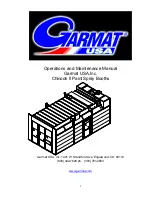
42
Under certain conditions, as shown above, no matter how long fan is operated, grain may not reach desired
moisture content that will allow it to be stored without spoilage. Keep in mind that air temperature and relative
humidity are not constant. Use daily averages for determining final moisture content.
shows recommended aeration when storing grain for short periods in a wet holding tank at various
moisture contents. These rates will only hold grain for lengths of time shown in
. If no aeration is
provided, grain may deteriorate much faster if small “hot spots” develop and produce heat and moisture,
accelerating deterioration. Aeration’s purpose is to prevent hot spots by keeping all grain at same temperature.
Table 18
- Wet Holding Tank Airflow Requirements
Moisture Content (%)
Airflow
Corn
Soybeans
Wheat
Rice
CFM/Bu
m³/hr/MT
14
10-11
12-13
10
1/10-1/8
8-10
15-17
12-13
14-15
11-12
1/7-1/5
11-15
18-20
14-Max
16-17
13-14
1/4-1/2
19-38
II.
Grain Storage
More grain is damaged and lost due to improper storage than for any other reason. Most common problems are:
Failure to check grain frequently during storage.
Failure to use aeration to control grain temperature, or holding grain too long without adequate aeration
prior to drying.
Failure to provide adequate insect control.
Failure to remove pockets of fines (broken kernels, weed seeds, trash) that restrict airflow and provide food
for insects and mold.
Failure to dry grain to a safe level of moisture content.
Improper cooling of grain after drying.
Moisture Content of Grain Storage
The length of time grain can be stored without aeration and the moisture content at which it is stored determine
whether there will be significant deterioration. Short-term storage generally refers to storage over winter, while
long-term storage spans more seasons. Grain with damaged kernels or with significant amounts of foreign
material needs to be stored at moisture levels 1 to 2 percentage points lower than clean grain. Contact local
elevator or bin dealer for recommended moisture contents and storage times.
shows recommended maximum moisture contents for safe grain storage. Values are for good-quality,
clean grain and aerated storage. Reduce 1% for poor quality grain, such as grain damaged by blight, drought, etc.
Table 19 -
Maximum Moisture Content for Safe Storage Under Typical Conditions
Grain
Moisture Content (%)
Shelled Corn & Sorghum
To be sold as #2 grain or equivalent by spring
15
To be stored up to 1 year
14
To be stored more than 1 year
13
Small Grains (e.g. oats, barley, etc.)
13
Soybeans
To be sold by spring
14
To be stored up to 1 year
12
Sunflowers
To be stored up to 6 months
10
To be stored up to 1 year
8
Wheat
13
Rice
12-1/2
Summary of Contents for Fastir
Page 4: ...Limited Warranty 4 LIMITED WARRANTY...
Page 50: ...Appendix A Wiring Diagrams 50 Figure 52 Double Auger Fastir Wiring Diagram...
Page 51: ...Appendix A Wiring Diagrams 51 Figure 53 Triple Auger Fastir Wiring Diagram...
Page 52: ...Appendix A Wiring Diagrams 52 Figure 54 Quadruple Auger Fastir Wiring Diagram...
















































